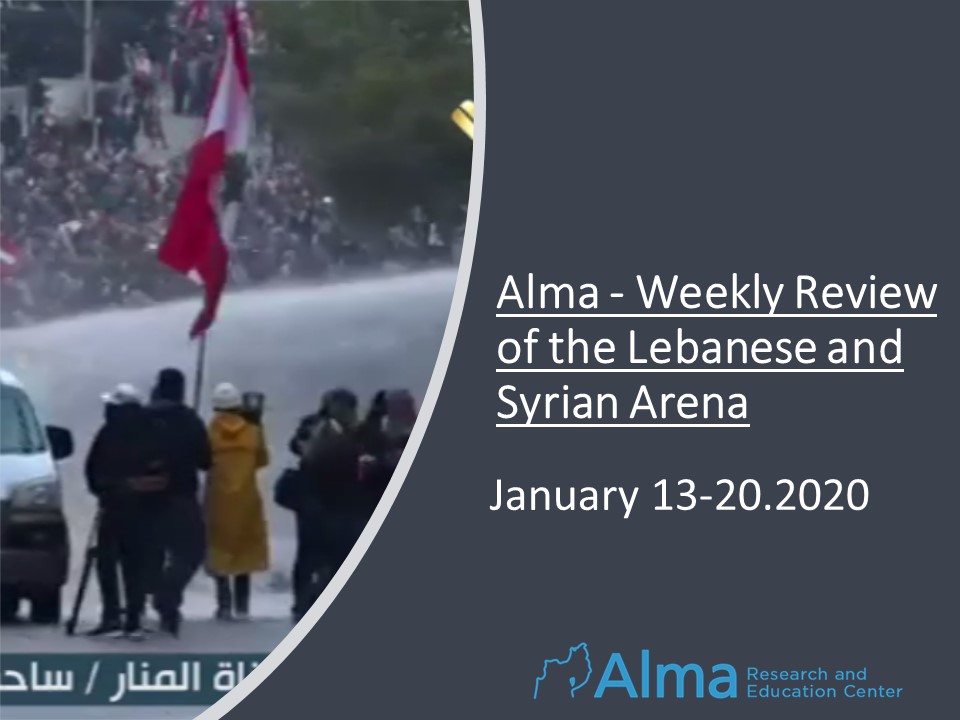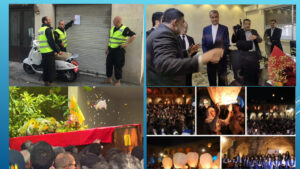[vc_row][vc_column][vc_column_text]Lebanon:
- Conflicting reports regarding the forming of a new government. On one-hand reports of a deadlock in the process, as opposed to reports of significant progress towards the forming of a viable government. At this point, it does not appear that the upcoming administration is to be a technocratic government, as demanded by the protesters.
- The Lebanese debt to the UN was paid and therefore its rights in the UN were reinstated ($ 310,466).
- Great Britain commenced the applying of the sanctions policy towards Hezbollah, after declaring all branches of the organization as a terrorist entity, (Military wing as well as the civilian wing).
- Following the financial crisis, there is a growing trend in real estate investments as an alternative to money deposits (for fear of losing / depreciation of deposits).
- The quiet demonstration period is over; this past week there has been escalation and deterioration of the situation.
- 13 January – Demonstrators gathered in front of the Finance Ministry on Bashar Al-Khuri Street in Beirut protesting the banks conduct and in protest of the Governor of the Central Bank. The blocking of roads and tire burning has resumed.
- 14 January – In clashes with protesters in front of the Lebanese central bank headquarters in Beirut, on Hamra Street, 47 members of the security forces were injured and 59 protesters were arrested. Protesters smashed the central bank’s windows, damaged ATMs and threw stones at several bank branches. Tear gas grenades fired by security forces landed in the Russian embassy’s yard in Beirut.
- 15 January – During the confrontation in western Beirut (Al-Alehou camp) 35 people were injured. Protesters protested the preventive detention of another 50 activists arrested throughout the evening.
- 16 January – The major roads blocked across the state: Beirut; The road in front of the sports arena in the direction of Al Ringh, the Druze community house junction and the Almazra promenade. Tripoli – the international Freeway, Elmullah Square and the main road in the Altbeni area. Baqa – Zahla Square, and Jedita Alayali Junction. Sidon – Alcia’a Road and Alia Square.
- 18-19 January – Severe clashes between protesters and security forces took place in front of the parliament building in Beirut in Alangma Square. The demonstrators hurled stones, fireworks and firecrackers against the security forces teargas and water jets. Hundreds were injured. (From 220 to more than 400 injured).
- There are reports of an arrest of a Lebanese journalist employed by a foreign press agency whose materials were published by an Israeli newspaper.
- Security forces reinforcements were transferred to Beirut.
[/vc_column_text][/vc_column][/vc_row][vc_row][vc_column][vc_column_text]Syria:
- 12 January – The Syrian Army General Headquarters held a memorial service in Assad National Library in Damascus to commemorate a week of the deaths of Qasem Soleimani and the Shiite militias who were with him. Speaking at the ceremony: Political Adviser and Public Relations attaché Bouthaina Shaaban, Deputy Minister of Defense, Amad Mahmoud Abdel Elohab, Syria’s Mufti, Ahmed Bad Al-Din Hasson, and Iran’s ambassador to Syria, Jawad Terek Abadi. The speakers praised Soleimani and talked among others things about his contribution to the implementation of the resistance that would continue at an even higher degree against the “Zionist enemy.”
The Iranian-Syrian connection is stronger than ever…[/vc_column_text][/vc_column][/vc_row][vc_row][vc_column][vc_single_image image=”3942″ img_size=”full” add_caption=”yes”][/vc_column][/vc_row][vc_row][vc_column][vc_column_text]2. 14 January – East of Homs, an aerial attack on the T-4 airfield. (Damage to a weapons warehouse / equipment and vehicles, most
likely three dead – their identity unknown).
3. 15 January – A gathering in the main square in Sweide protesting the high cost of living and living conditions, calling out to
do justice with “the corrupt…”
4. A debate on social networks for and against; on the one hand, the Syrian government is being attacked due to the economic situation and the hashtag: “we want to live” received a strong resonance. On the other hand, supporters of the regime expressed
concern that the protest would encourage others in other areas to take to the streets. An interesting point concerning the above
gathering and protest was its publication by the official Syrian news agency.[/vc_column_text][/vc_column][/vc_row][vc_row][vc_column][vc_single_image image=”3955″ img_size=”full” add_caption=”yes”][/vc_column][/vc_row][vc_row][vc_column][vc_column_text]5. The bombings and skirmishes in the Idlib area continue:
The dispatching of flyers by the Syrian army, which “recommend” residents to leave Idlib and West Halab through safe passages:
- Al Habit – 50 km south of Idlib.
- Abu Al D’hahor – 40 km southeast of Idlib.
- Al Hadher – 20 km south of Aleppo.
For now, not many civilians are heeding to the call despite the intensity of the fighting. In recent days dozens and even more fatalities have been reported on both sides.
6. 13 January – In Moscow, Syrian and Turkish intelligence chiefs met to discuss a ceasefire in Idlib and possible coordination against the Kurdish forces. However, at this stage without results.
7. The “Turkanisation policy“ led by the Turkish government throughout the area of northern Syria under its control and under its militia’s control:
- The raising of the Turkish flag on government buildings and the services rendered by the Turks in these areas as well as the displaying of portraits of Turkish President Recep Tayyip Erdoğan.
- The names of the government institutions and services in these areas are in the Turkish language.
- The last act was carried out in the town of Jarabulus on 12 January, at a high school inauguration. The high school was named after Turkish Governor Ahmad Thurgay’s Amam Gilar, who died of a cardiac arrest in the town a year ago.
[/vc_column_text][/vc_column][/vc_row][vc_row][vc_column][vc_images_carousel images=”3958,3957,3959″ img_size=”full” autoplay=”yes”][/vc_column][/vc_row]






